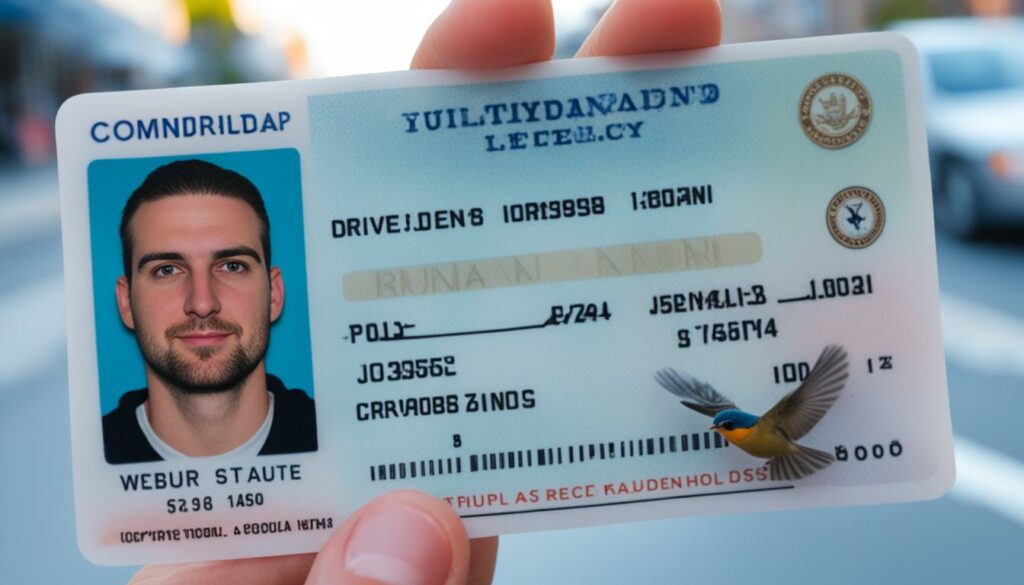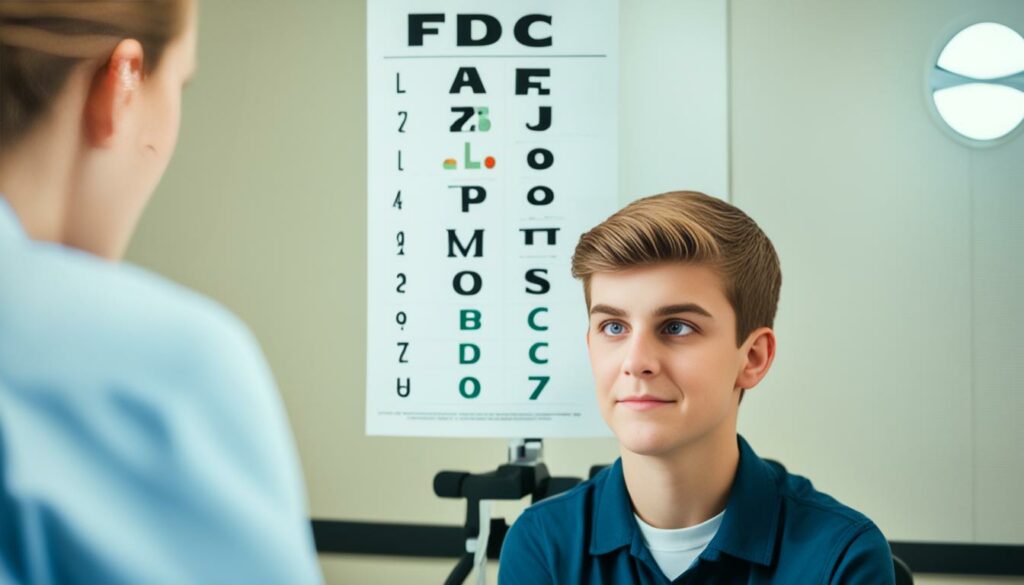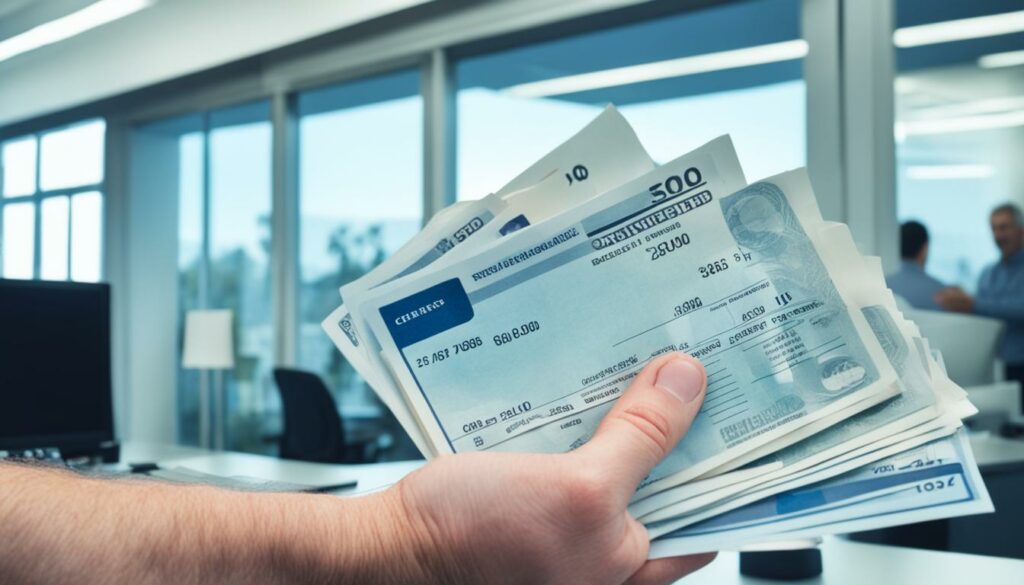Get Your Permit at 17 – Simple Guide & Tips
Are you eager to get your driver’s permit at 17? Getting your permit is an important milestone on your journey to becoming a licensed driver. In this guide, we will walk you through the process of obtaining your permit as a 17-year-old in the United States, including the steps, requirements, and tips to help you succeed.
Before you can hit the road, it’s vital to familiarize yourself with the specific requirements for applying and testing in your jurisdiction. Let’s begin by exploring the essential steps to obtain a permit at 17.
Key Takeaways:
- To get your permit at 17, you need to find the nearest Department of Motor Vehicles (DMV) office and submit an application.
- Provide proof of identity, such as your social security card, birth certificate, or passport.
- Pass an eyesight exam to ensure your vision meets the required standards for driving.
- Pay any associated fees, including application, eyesight exam, and written test fees.
- Study the driver’s handbook to prepare for the written knowledge test, which covers road, traffic, and safety rules.
Study the Requirements and Find the DMV Office

Before applying for your permit, it’s important to familiarize yourself with the specific requirements that apply to your jurisdiction. By understanding the necessary documents and steps involved, you can ensure a smooth application process. Additionally, you’ll need to find the nearest DMV office to apply for your permit, where you’ll also pay any necessary fees and take the written driving theory test.
Studying the permit requirements is crucial as it helps you gather the correct documentation and fill out your application accurately. Each state may have different requirements, so it’s essential to consult the official website of your state’s department of motor vehicles for specific guidelines.
Gathering the Required Documents
When applying for your permit, you will typically need documents such as:
- Proof of identity (e.g., birth certificate, social security card, passport)
- Proof of residency (e.g., utility bill, lease agreement)
- Parental consent if you’re under 18 years old
It’s important to gather these documents beforehand to avoid any delays in the application process.
Finding the Nearest DMV Office
To find the nearest DMV office where you can apply for your permit, you can visit the official website of your state’s department of motor vehicles. They usually provide a search function that allows you to enter your ZIP code or address to locate the nearest office.
Paying the Necessary Fees
When applying for your permit, certain fees may apply. These fees help cover the administrative costs associated with processing your application. The exact amount and payment methods accepted may vary by state. It’s advisable to prepare the necessary funds in advance to avoid any complications during the application process.
Taking the Written Driving Theory Test
As part of the permit application process, you’ll be required to take a written driving theory test. This test assesses your knowledge of road rules, traffic signs, and driving safety. To pass the test, it’s essential to study the driver’s handbook provided by your state’s department of motor vehicles. This handbook offers valuable information on driving laws and best practices that will help you succeed in the written test.
Once you’ve studied the requirements, gathered the necessary documents, found the nearest DMV office, and prepared for the written driving theory test, you’ll be ready to embark on the journey towards obtaining your driving permit.
| Permit Requirements Checklist | DMV Office Locator | Fee Schedule |
|---|---|---|
| – Proof of identity | – Search by ZIP code or address | – Application fee |
| – Proof of residency | – Nearest DMV office address | – Written test fee |
| – Parental consent (if under 18) | – Office hours and contact details | – Other applicable fees |
Submit an Application and Provide Proof of Identity

Once you have located the DMV office, it’s time to submit your permit application. The application will require you to provide various personal information, including your full legal name, date of birth, home address, hair color, and eye color. This information is necessary for identifying you and determining your eligibility for a driving permit.
In addition to the application, you will need to provide proof of your identity. This is to ensure that you are who you claim to be and to prevent any identity theft or fraudulent activities. Acceptable forms of identification may include your social security card, birth certificate, passport, or any other recognized form of photo ID.
It is important to note that each state has its own requirements and acceptable forms of identification, so be sure to check the specific guidelines provided by your state’s DMV. Some states may also require additional documents or proofs, so it’s crucial to gather all the necessary paperwork before visiting the DMV office.
Most importantly, make sure to bring the original documents with you as some DMVs do not accept photocopies. This is to ensure the authenticity and validity of your identification.
| Accepted Documents for Proof of Identity |
|---|
| Social Security Card |
| Birth Certificate |
| Passport |
| Valid Photo ID (Driver’s License, State ID Card) |
| Proof of Immigration Status (if applicable) |
Note: The above table provides examples of commonly accepted documents. The specific requirements may vary depending on your state, so always refer to your state’s DMV guidelines for the most accurate and up-to-date information.
Additionally, it’s important to meet the minimum age requirement set by your state for obtaining a driving permit. While most states require individuals to be at least 15 years old, there are a few states that issue permits to drivers as young as 14. Be sure to check the age requirements specific to your state.
Submitting your application and providing proof of identity are crucial steps in the process of obtaining your driver’s permit. It is important to follow the guidelines provided by your state’s DMV and come prepared with all the necessary documents to ensure a smooth application process.
Take an Eyesight Exam

As part of the permit application process, one of the essential steps is to undergo an eyesight exam. The purpose of this exam is to determine if your visual acuity is sufficient for safe driving. During the exam, you may be required to read letters or identify shapes and details on a chart from a specific distance.
Eyesight plays a crucial role in your ability to operate a vehicle safely. Poor vision can hinder your recognition of road signs, pedestrians, or obstacles, increasing the risk of accidents. If your performance on the eyesight exam is not satisfactory, you may need to wear corrective eyewear while driving, such as glasses or contact lenses. It is important to follow any guidelines or restrictions mentioned on your learner’s permit regarding the use of corrective eyewear.
Regular vision check-ups and wearing the appropriate corrective eyewear, if required, can significantly improve your chances of maintaining good visual acuity and ensuring your safety on the road.
Pay Any Associated Fees

While pursuing your driver’s permit, it’s important to be aware of the various fees associated with the application process. These fees cover essential aspects such as the application itself, the eyesight exam, and the written test. Although the specific fee amounts may differ depending on your state, it’s crucial to allocate the necessary funds to cover these expenses. Passing the written test on your first attempt will help you avoid additional fees for retests.
Fees Breakdown
| Fee Type | Amount |
|---|---|
| Application Fee | $X.XX |
| Eyesight Exam Fee | $X.XX |
| Written Test Fee | $X.XX |
| Total | $X.XX |
“Paying the necessary fees on time ensures a smooth permit application process and allows you to focus on preparing for your written test and building your driving skills.”
By being prepared and understanding the fees involved, you can navigate the permit application process with ease and avoid any unnecessary delays. Budgeting for these fees will allow you to smoothly progress towards obtaining your driver’s permit.
Study the Driver’s Handbook
To prepare for the written knowledge test, it is important to study your state’s driver’s handbook. This comprehensive guide contains valuable information on driving laws, basic skills, and road signs and symbols. By reviewing the handbook, you can familiarize yourself with the rules of the road and the expectations of a responsible driver.
Take the time to read and understand the sections that cover driving laws in your state. This will ensure that you are aware of important regulations such as speed limits, right-of-way rules, and traffic signal meanings. Understanding these laws is essential for safe and legal driving.
Additionally, the driver’s handbook provides guidance on basic driving skills. It covers fundamental techniques such as proper steering, braking, and accelerating. By reviewing and practicing these skills, you can develop a solid foundation for your driving journey.
Another crucial aspect of the driver’s handbook is the section on road signs and symbols. This section illustrates the various signs you will encounter on the roads, and provides explanations for their meanings. Familiarizing yourself with these signs will enable you to understand and respond to them appropriately while driving.
Tip: To make the studying process more effective, create flashcards or use online resources that provide interactive quizzes based on the driver’s handbook. This will help you test your knowledge and reinforce your understanding of the material.
Remember, studying the driver’s handbook is not just about passing the written knowledge test. It is about acquiring the knowledge and skills necessary to become a responsible and confident driver. Take the time to thoroughly review the handbook and commit important information to memory.
Driver’s Handbook Study Tips:
- Read a few pages every day: Instead of trying to cram all the information at once, set aside a few minutes each day to read a few pages of the driver’s handbook. This consistent approach will help you absorb the material more effectively.
- Create a study schedule: Designate specific times during the week to focus on studying the driver’s handbook. Consistency and structure will help you stay on track and retain the information better.
- Take notes: Jot down key points or important facts as you go through the handbook. This will not only help you remember the information better, but also provide you with a handy reference for future revision.
- Use mnemonic devices: Mnemonic devices, such as acronyms or rhymes, can help you remember complex information or sequences. Create your own mnemonics to make memorization easier.
- Test yourself: Take practice tests or quizzes based on the driver’s handbook material to assess your knowledge. This will help you identify areas that require further review and improve your overall understanding.
- Review regularly: Don’t just study the driver’s handbook once and forget about it. Set aside time for regular review sessions to reinforce your knowledge and keep the information fresh in your mind.
Familiarize Yourself with Vehicle Parts and Functions

Spend some time with a licensed driver or a parent going over the different parts of a car, both inside and out. It’s essential to understand the functions of various car components to drive safely and pass your written test. Let’s take a closer look at some important features of a car:
Headlights
The headlights of a car provide illumination to ensure visibility when driving at night or in low-light conditions. They also allow other drivers to see your vehicle on the road. Turn on your headlights when it’s dark, foggy, or raining.
Turn Signals
Turn signals, also known as blinkers or indicators, are used to communicate your intention to turn or change lanes to other drivers. Activate the appropriate turn signal before making a turn or merging into another lane.
Parking Brake
The parking brake, also referred to as the handbrake or emergency brake, is a mechanical device used to keep the vehicle stationary when parked. It should be engaged whenever you park your car on an incline or need to ensure it remains in place.
Windshield Wipers
Windshield wipers are responsible for clearing rain, snow, dirt, or other debris from your windshield, ensuring optimal visibility. You can control the speed and intensity of the wipers to match the weather conditions.
Knowing how these components work and their functions will contribute to your understanding of vehicle operation. It’s important to familiarize yourself with your particular car model, as some features may vary slightly.
| Car Component | Function |
|---|---|
| Headlights | Provide illumination for night driving and visibility to other drivers. |
| Turn Signals | Indicate intentions to turn or change lanes. |
| Parking Brake | Keeps the vehicle stationary when parked. |
| Windshield Wipers | Clears windshield from rain, snow, or other debris for better visibility. |
By familiarizing yourself with these essential car components and understanding their functions, you’ll be better prepared to operate a vehicle safely and confidently.
Consider Taking a Driver’s Ed Course
Enrolling in a driver’s ed course can provide further education and preparation for getting your permit. Many public schools offer special classes for students nearing the age of eligibility for a permit. In these classes, you will learn more about traffic laws, safe driving techniques, and important skills like handling and parking. Some states may even allow you to substitute a comprehensive exam taken at the end of a driver’s ed course for the written test given at the DMV. Check with your local DMV to see if driver’s ed is required in your state.
| Benefits | Description |
|---|---|
| 1. Enhanced knowledge of traffic laws | Driver’s ed courses provide in-depth education on traffic laws, helping you understand and adhere to the rules of the road. |
| 2. Learning safe driving techniques | These courses teach you defensive driving skills, accident avoidance techniques, and strategies for handling various road conditions. |
| 3. Comprehensive exam substitution | In some states, completing a driver’s ed course and passing a comprehensive exam may allow you to skip the written test at the DMV. |
| 4. Practical driving experience | Driver’s ed courses typically include behind-the-wheel training, giving you the opportunity to practice driving under the guidance of a qualified instructor. |
| 5. Insurance discounts | In certain cases, completing a driver’s ed course can make you eligible for insurance discounts, potentially saving you money on premiums. |
By enrolling in a driver’s ed course, you can gain valuable knowledge and skills that will help you become a safer and more confident driver. Additionally, it may offer the added benefit of expediting the permit application process. Consider this option to enhance your driving education and increase your chances of passing the necessary exams with flying colors.
Take and Pass the Permit Test
When it comes to getting your driver’s permit, passing the written test is a crucial step. This test evaluates your knowledge of road rules, traffic signs, and driving regulations. To ensure success, it’s essential to understand the testing requirements and prepare accordingly.
On the day of your scheduled written test, make sure to arrive early at the testing center. Bring any necessary identification documents and payment for fees. While the test is usually conducted on a computer, it’s a good idea to have a pencil or pen with you, just in case.
To perform your best, it’s vital to be well-rested and nourished before the test. This will help improve your concentration and alertness, increasing your chances of success. Take your time to read each question carefully and answer to the best of your ability. Remember, there is no penalty for guessing, so if you’re unsure about a question, make your best guess.
If, unfortunately, you don’t pass the test on your first attempt, don’t get discouraged. Multiple attempts are usually permitted, allowing you to schedule a new testing date and retake the permit test. Take the opportunity to review the areas where you struggled and focus on studying those specific topics. With dedication and perseverance, you’ll achieve the passing grade and be one step closer to obtaining your driver’s permit.
Testimonials
“Studying for the permit test was challenging, but with consistent effort and preparation, I was able to pass on my first attempt. The key is to focus on understanding the rules of the road and practice answering sample questions. Don’t forget to manage your time during the test and review your answers before submitting. Good luck!” – Samantha
“I didn’t pass the permit test on my first try, but that didn’t deter me. I took it as an opportunity to review my weak areas and study even harder. The second time around, I was more confident and well-prepared, and I passed with flying colors. Don’t give up if you don’t succeed initially. Keep pushing forward!” – Michael
“Taking the permit test can be nerve-wracking, but remember that it’s just a stepping stone. Take your time, read the questions carefully, and trust in the knowledge you have gained through studying. If you don’t pass on your first attempt, don’t get discouraged. Learn from the experience and go for it again! You’ve got this.” – Emily
Wait for Your Permit to Arrive and Log Driving Hours
After passing the permit test, the DMV will process your information and mail you a physical copy of your learner’s permit. Keep your permit safe and easily accessible, as you will need to present it when driving. At this stage, you can start logging the required number of driving hours, typically under the supervision of a licensed adult driver. Some states also require the completion of a driver’s education course. It’s important to practice driving and gain experience before taking the road test for your driver’s license. Check the specific requirements in your state regarding the number of hours required and any additional conditions.
| Number of Driving Hours | Supervision Requirements |
|---|---|
| 40 hours | 10 hours of night driving |
| 60 hours | 20 hours of night driving |
| 100 hours | 40 hours of night driving |
Conclusion
Obtaining your driver’s permit at 17 is a crucial milestone on your journey to becoming a licensed driver. Throughout the permit application process, it is essential to adhere to the specific requirements set by your jurisdiction. This includes submitting a complete application, providing proof of identity, and passing an eyesight exam.
However, obtaining your permit is not just about paperwork. You must also invest time and effort into studying for the written test. Familiarize yourself with your state’s driver’s handbook and review important driving laws, road signs, and safety regulations. By thoroughly preparing for the written test, you can confidently demonstrate your understanding of the rules of the road.
In addition to studying, practicing your driving skills under the supervision of a licensed adult is vital. Take advantage of the opportunity to build experience and confidence behind the wheel. Remember, safe and responsible driving requires not only knowledge but also practical skills that can only be acquired through practice.
As you embark on your journey to obtain a driver’s permit at 17, remember to always drive with caution and abide by the rules of the road. By following the proper procedures, studying diligently, and honing your driving skills, you will be well-prepared for the next step towards obtaining your driver’s license.
FAQ
How do I get my permit at 17?
To get your permit at 17, you need to familiarize yourself with the specific requirements for applying and testing in your jurisdiction. Find the Department of Motor Vehicles (DMV) office nearest to you, submit an application, provide proof of identity, pass an eyesight exam, and pay any associated fees.
Where can I find the DMV office to apply for my permit?
You can find the nearest DMV office where you can apply for your permit by checking the website of the department of motor vehicles that governs your area.
What documents do I need to bring to the DMV office for my permit application?
You will need to provide proof of identity, which may include your social security card, birth certificate, passport, or other recognized form of photo ID. Make sure to bring the original documents with you, as some DMVs do not accept photocopies.
Do I need to take an eyesight exam for my permit?
Yes, as part of the permit application process, you will need to take an eyesight exam to ensure that your vision is good enough for you to safely operate a vehicle.
What fees do I need to pay for my permit?
You will need to pay any associated fees for the permit process, which can include an application fee, an eyesight exam fee, and a fee for the written test. The specific fees and requirements may vary depending on the state you are in.
How can I prepare for the written knowledge test for my permit?
To prepare for the written knowledge test, it is important to study your state’s driver’s handbook, which contains up-to-date information on driving laws, basic skills, and road signs and symbols. Enrolling in a driver’s ed course can also provide further education and preparation.
What important parts of a car should I familiarize myself with for the permit test?
Spend some time with a licensed driver or a parent going over the different parts of a car, both inside and out. Learn about important features such as the headlights, turn signals, parking brake, and windshield wipers.
Should I consider taking a driver’s ed course?
Yes, enrolling in a driver’s ed course can provide further education and preparation for getting your permit. Check with your local DMV to see if driver’s ed is required in your state.
What happens after I pass the permit test?
After passing the permit test, the DMV will process your information and mail you a physical copy of your learner’s permit. Keep your permit safe and easily accessible, as you will need to present it when driving.
Can I start driving on my own with a learner’s permit?
No, with a learner’s permit, you can start logging the required number of driving hours, typically under the supervision of a licensed adult driver. Some states also require the completion of a driver’s education course.
What is the importance of obtaining a driver’s permit at 17?
Obtaining your driver’s permit at 17 is an important step toward becoming a licensed driver. It allows you to gain valuable experience and knowledge necessary for safe and responsible driving.







